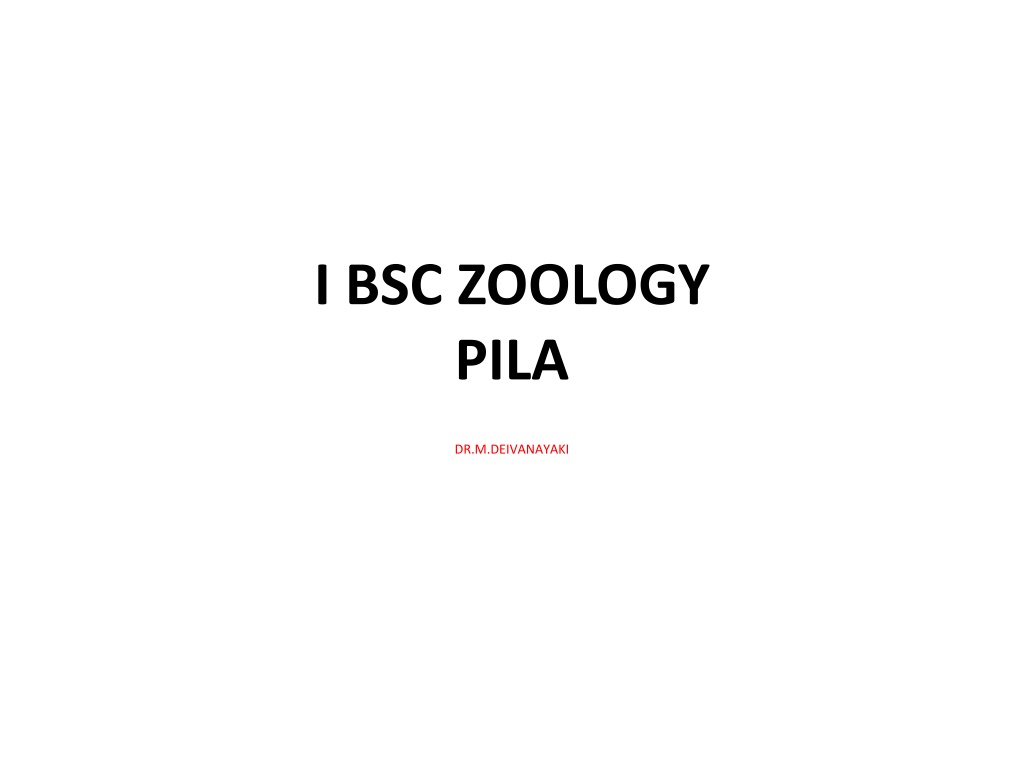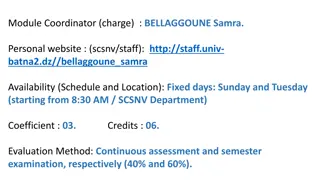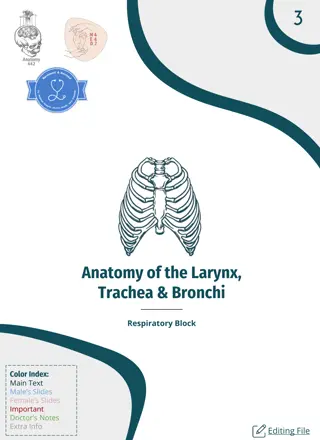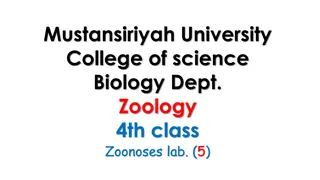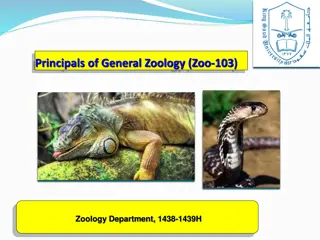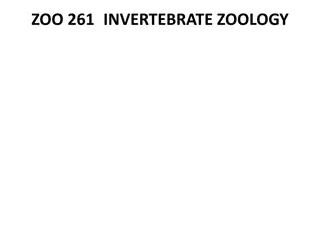Exploring the Anatomy and Behavior of Pila Globosa in Zoology
Discover the fascinating world of Pila Globosa, or the apple snail, through detailed descriptions of its habitat, external features, organ systems, and reproductive processes. From its adaptation to amphibious life to the intricate structure of its spiral shell, delve into the biology of this freshwater mollusc.
Download Presentation

Please find below an Image/Link to download the presentation.
The content on the website is provided AS IS for your information and personal use only. It may not be sold, licensed, or shared on other websites without obtaining consent from the author. Download presentation by click this link. If you encounter any issues during the download, it is possible that the publisher has removed the file from their server.
E N D
Presentation Transcript
I BSC ZOOLOGY PILA DR.M.DEIVANAYAKI
Contents: Habit and Habitat of Pila Globosa External Features of Pila Globosa Coelom of Pila Globosa Digestive System of Pila Globosa Respiratory Organs of Pila Globosa Blood Vascular System of Pila Globosa Excretory System of Pila Globosa Nervous System of Pila Globosa Sense Organs of Pila Globosa Reproductive System of Pila Globosa Copulation of Pila Globosa Fertilisation of Pila Globosa Development of Pila Globosa
Habit and Habitat of Pila Globosa: Pila globosa or the apple snail is one of the largest freshwater molluscs. It is commonly found in freshwater ponds, pools, tanks, lakes, marshes, rice fields and sometimes even in streams and rivers. They occur in those areas where there is a large amount of aquatic vegetation like Vallisneria, Pistia, for food. They are amphibious being adapted for life in water and on land. ADVERTISEMENTS: The animal creeps very slowly by its ventral muscular foot, covering about five cm per minute. The movement of the animal is like the gliding movement of planarian. During the rainy seasons Pila comes out of the ponds and makes long terrestrial tours, thus, respiring air directly. It can overcome long periods of drought in a dormant condition and buried in the mud; this period of inactivity is called aestivation or summer sleep.
External Features of Pila Globosa: Shell of Pila: Pila globosa. Shell seen from ventral surface
The shell of Pila globosa, as in other Gastropoda, is univalve but coiled around a central axis in a right-handed spiral. ADVERTISEMENTS: The top of the shell is the apex which is formed first and growth of shell takes place from it, the apex contains the smallest and the oldest whorl. Below the apex is a spire consisting of several successively larger whorls or coils followed by penultimate whorl and the largest whorl or body whorl which encloses most of the body. The lines between the whorls are called sutures. Internally all the whorls of the shell are freely communicated with one another; such a shell is called unilocular. The body whorl has a large mouth or opening, the margin of the mouth is called a peristome from which the head and the foot of the living animal can protrude. When viewed from the ventral side with the peristome facing the observer, the mouth lies to the right of the columella and the shell is spiralled clockwise, then it is spoken of as being right-handed or dextral. The outer margin of the mouth is called an outer lip, and the inner margin as inner or columellar lip. In the centre of the shell runs a vertical axis or columella around which the whorls of the shell are coiled; the columella is hollow and its opening to the exterior is known as an umbilicus. Shells with an umbilicus are umbilicate or perforate. The lines of growth of shell are visible, some of them appear as ridges known as varices. The shell of Pila globosa varies in colour from yellowish to brown or even blackish.
Operculum of Pila Globosa: Fitting into the mouth of the shell is a calcareous operculum, its outer surface shows a number of rings of growth around a nucleus; the inner surface has an elliptical boss for attachment of muscles, the boss is cream- coloured and is surrounded by a groove. The operculum is, in fact, secreted by the glandular cells of the foot.
Pila globosa. Front view of the animal after removal of the shell Pila globosa. A female individual dissected to show the organs of the pallial cavity
. Mantle: The mantle, also referred to as pallium, covers the visceral mass and it forms a hood over the animal when it is withdrawn. The edge of the mantle is thick and contains shell glands which secrete the shell, above the thickened edge there is a supra-marginal groove. The mantle also has two fleshy lobes called nuchal lobes or pseudepipodia which are joined on either side of the head. The left pseudepipodium forms a long tubular respiratory siphon for aerial respiration and a respiratory current enters, through it, the right pseudepipodium is less developed and not a regular tube, respiratory current passes out through it
Mantle Cavity and Pallial Complex: In the anterior part there is a large space between the mantle and the body, this is a mantle or pallial cavity which has been shifted to the front by a process of torsion. It encloses a number of organs and the head can be withdrawn into it. The mantle or pallial cavity encloses within it a number of important organs which are collectively known as pallial complex. Near the right pseudepipodium is a prominent ridge or epitaenia which runs backwards up to the end of the mantle cavity, it divides the mantle cavity into a right branchial cavity and a left pulmonary sac. In the branchial cavity or chamber lie a single gill or ctenidium, rectum and anus, the genital aperture and the anterior chamber of the kidney as a reddish mass near the posterior end of the epitaenia. Near the left pseudepipodium is a fleshy osphradium a typical molluscan sense organ. 3. Coelom of Pila Globosa: The coelom is reduced to unpaired cavities of pericardium, kidney and gonad. The renal and pericardial cavities communicate, but the cavity of gonad is unconnected. The visceral organs are surrounded by means of sinuses or spaces containing blood. These blood-filled spaces constitute the haemocoel.
Digestive System of Pila Globosa: The digestive system of Pila Globosa comprises: 1. A tubular alimentary canal 2. A pair of salivary glands 3. A large digestive gland (i) Alimentary Canal: The alimentary canal is distinguished into three regions, viz: 1. The foregut or stomodaeum including the buccal mass and oesophagus, 2. The midgut or mesenteron consisting of stomach and intestine, and 3. The hindgut or proctodaeum comprising the rectum. The midgut alone is lined by endoderm, while the other two are lined by ectoderm. 1. Foregut: The foregut includes the mouth, buccal mass and oesophagus. (i) Mouth: The mouth is a narrow vertical slit situated at the end of snout. There are no true lips but the plicate edges alone serve as secondary lips. (ii) Buccal Mass: The mouth leads into a large cavity of buccal mass or pharynx having thick walls with several sets of muscles. The anterior part of the cavity of buccal mass is vestibule. Behind the vestibule are two jaws hanging from the roof of the buccal mass. The jaws bear muscles and their anterior edges have teeth-like projections for cutting up vegetable food. Buccal Cavity: Behind the jaws is a large buccal cavity. On the floor of the buccal cavity is a large elevation called odontophore. The front part of odontophore has a furrowed subradular organ which helps in cutting food. The odontophore has protractor and retractor muscles and two pairs of cartilages, a pair of triangular superior cartilages which project into the buccal cavity, and a pair of large S- shaped lateral cartilages.
NERVE GANGLIC : 1. Cerebral ganglia 2. Pedal ganglia 3. Visceral ganglia 4. Pleural ganglia 5. Supra and infra intestinal ganglia. a) On the dorso-lateral sides of the buccal mass cerebral ganglia are present. They are connected by cerebral commisures. b) On the ventrolateral sides of the buccal mass a pair pleural and a pair pedal ganglia are present. The cerebral ganglia and pleural ganglia are connected by .c :rebro-pleural connectives. The cerebral and pedal ganglia are connected by cerebro-pedal connectives. c) The two pedal ganglia are connected by pedal commisure. All these structures will form a nerve ring which looks like a square. d) At the junction of buccal mass and oesophagus two buccal ganglia are present. They are connected in the cerebral ganglia with connectives c) In the visceral mass two visceral ganglia are present. The pleural ganglia and visceral ganglia are connected by right and left pleuro- visceral connectives.
From the right pleural ganglion a supra intestinal nerve will arise. It will travel over the oesophagus and is connected to the left pleuro-visceral connective. At this point, it form a supra intestinal ganglion. f) Left pleural ganglion gives a nerve which connects with right pleuro-visceral connective and a infra intestinal ganglion is formed. Thus these nerves will give '8' shaped structure. g) From cerebral nerve ganglia a number of small nerves will arise. They travel to tentacles, eyes, statocysts etc. h) From pleural tjerve ganglia nerves will arise and will innervate mantle. i) From visceral ganglia nerves will go to excretory organs, reproductive organs, and to stomach. Thus a well-developed nervous system is seen in the pila. Email ThisBlogThis!Share to TwitterShare to Facebook
Male Reproductive System It shows testis, vas deferens and penis. 1. Testis: Only one testis is present. It is present in the visceral mass. 2. Vas deferens: From testis a number of vas efferentja will arise. They unite to form vas deferens. This is divisible into 3 parts. Proximal tubular part: It is thin tube, it is narrow. Middle curved part: It is curved. It is bulged. It will store sperms. Distal glandular part: The last part is glandular. It will open on the genital papilla. 3. Penis: In front the anus from the edge of mantle a curved penis will arise ii is called Penis. It shows a groove. Through this groove sperms will travel Hypo branchial gland: Near the base of penis a big hypo-branchial gland is present. Its functions are not clearly known. Sperms: In pila two types of sperms are formed. Enpyrene type: They are thin. They show head, middle piece and tail. They are 25 microns in length. They can swim. The tail has a cilium. These sperms can fertilize the ovum. Oligopyrene sperms: These are sickle shaped. They show 4 to 5 cilia. They are 32.5 microns in length. Specific head is not seen. They cannot move They can never fertilise.
Female Reproductive System In the female reproductive system ovary, oviduct, seminal receptacle and uterus are present. 1. Ovary: It is present above the hepato-pancreas. It is branched. It is light orange coloured. When it is mature it becomes black. It gives oviduct. 2. Oviduct: It is a narrow duct. It opens into seminal receptacle. 3. Seminal Receptacle:It is bean shaped bulged organ. It will receive the sperr s from male during copulation. 4. Utirus: It is a big yellow coloured sac. Seminal receptacle will open into it. At it a 2X vagina is present. It opens out through female genital aperture near the anus. Copulation In the rainy season copulation will take place between male and female >ilas. Male and female will attach in opposite directions. Male will inject sperms through penis into the seminal receptacle of the female. Fertilisation In the uterus fertilization is carried on. They are liberated on moist places by female. They hatch and give small organism which resemble the adult pila.
